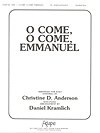The Clearinghouse of Choreography

O Come, O Come, Emmanuel

(Last updated: July 31, 2005)
Table Setup:
remove C#5 & D#5
place G4 in C#5 position
place A4 in D#5 position
place B6 above G#6
move F#6 to the space next to D#6
setup F6\D6 cluster & place between A#5 & C#6
Choreography:
m. 31: after playing D5, place it between A4 & F#5
m. 39: disassemble F6/D6 cluster & return F6 to home position
m. 41: pass D6 from right hand to left
m. 42: keep D6 in left hand as constant, create D6/F6 cluster
m. 43: return F6 to home position after playing
m. 44: pass C6 from right hand to left
m. 45: keep A5 in left hand as constant, create A5/G5 cluster
m. 47: pass F5 from right hand to left & create E5/F5 cluster
m. 50: damp A6/G5 cluster (as a unit) in the G5 spot.
m. 51: tie the F5 half note to the F5 quarter note, if desired. Damp the E5/F5 cluster (as a unit) in the E5 spot. During the railroad tracks, pick up A5 with right hand & G5 with left.
m. 52: pick up F5 with left hand from top of cluster
m. 54: damp D5 between A4 & F#5, Damp A5 in B5's spot
m. 55: after playing the B5, place it in F#6's spot (so, it'll be between F#6 and G#6)
m. 58: hold the D6 as a constant, creating D6/F#6 (it's best to create the cluster before starting the triplet)
m. 59: return F#6 to its previous position and D6 to its home position
m. 60: keep C#6 in left hand as a constant, create C#6/A5 cluster. Return A5 to B5's position after playing, if desired.
m. 61. keep C#6 in left hand as a constant, create C#6/E6 cluster. Release E6 into its home position after playing
m. 62: hold the B5 as a constant, creating D6\B5 (it's best to create the cluster before starting the triplet)
m. 63: return D6 to its home position and return B5 to F#6's spot
m. 65: because E6 is rung with the left hand, the F#6 is already in the right (no need to pass, as is indicated in the music)
m. 68 & 69: I don't play the shakes
m. 71: hold the D6 as a constant, creating D6/F#6 (it's best to create the cluster before starting the triplet)
m. 72: return F#6 to its previous position and D6 to its home position
At least two options exist for m. 73-75:
-
Option 1 (This is the way I play it):
-
-
m. 73: beat 4, play only C#6, create D#6\\F#6 cluster
-
-
m. 74: ring just the D#6\\F#6 (leaving out the B5), create the B5//B6 cluster for the final chord. (I don't do the shake.)
-
-
Option 2:
-
m. 72: after playing B5, lay it on top of C#6, creating B5/C#6 cluster. Damp D6 in its home position after playing it.
-
-
m. 73: after beat 4, create D#6\\F#6 cluster (without damping the F#6!). Release C#6 into its home position after playing it.
-
-
m. 74 create B5//B6 cluster for final chord
-
-
(Yes, there is time to do all of this — take full advantage of the "molto rit. al fine" for a big dramatic ending!)

All content © 2003 through 2010 Michèle Sharik and TheGoldenDance.com unless otherwise noted.
Original "Golden Dancer" figure by Elizabeth Kennedy.
"Scribble Dancer" figure by Gretchen Rauch.
Contact information:
Fax: +1-866-561-0186 (toll-free)
Email:
(replace the word "at" with the @ sign)







